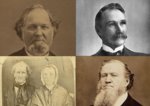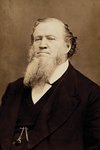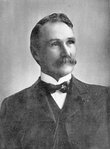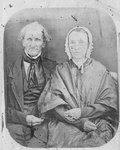





My favorite Oregon Trail pioneer, Matilda (Glover) Koontz Jackson, crossed the Oregon Trail in 1847 with her four sons and watched her husband, Nicholas, drown in the Snake River at Three Island Crossing. She later married John R. Jackson and lived the rest of her life at his home south of Chehalis.
But she wasn’t the only local pioneer in the 26 wagon trains to travel west in 1847. In fact, many of the 1847 Oregon Trail pioneers left deep roots in the Pacific Northwest.
Consider Joseph Carey Geer Sr., a Connecticut native and veteran of the War of 1812 who traveled west from Illinois with his wife, Mary, a Rhode Island native, and their eight children. Their son Heman Johnson Geer, who was 19 at the time, became the father of the first native-born governor of Oregon, Theodore Thurston Geer, who served from 1899 to 1903. Their son Ralph Carey Geer, who was 31, crossed the trail with his wife, Mary, and their four children. He later became a farmer and politician who served in the Oregon House of Representatives. Their daughter, Francis Emeline Geer, was the wife of John Walker Grim, who also crossed on the Oregon Trail in 1847. He became the first territorial judge of Oregon and later a Marion County commissioner, probate judge and state senator.
Or David Shelton, a North Carolina native who became the founder of Shelton. He and his wife, Frances (Wilson) Shelton, left St. Joseph, Missouri, May 9, 1847, to venture west across the Oregon Trail and arrived at Fort Vancouver with only a dollar in his pocket with which to buy flour and syrup. They stayed in Portland until early 1852, when they traveled to the Puget Sound aboard a schooner with Loren B. Hastings (who had also crossed the Oregon Trail in 1847 with his wife, Lucinda) and Francis Pettygrove, early residents of Port Townsend, according to historylink.org. Like John R. Jackson, Shelton served as a delegate to the Territorial Legislature. He and his wife established a farm in 1853 at the head of Hammersley’s Inlet, also known as “Big Skookum Bay” or Oakland Bay. The nearby community in what became Mason County was first called Sheltonville. When Shelton was incorporated in 1890, David Shelton became the first mayor.
And Brigham Young, the Vermont native who succeeded founder Joseph Smith as president of the Church of Jesus Christ of Latter-day Saints, finished his trek across the nation from Nebraska to found Salt Lake City in 1847. He apprenticed as a carpenter and painter before becoming a preacher of Joseph Smith’s Book of Mormon. After an armed mob killed Joseph Smith in Carthage, Illinois, June 27, 1844, Young led Mormon followers to Nebraska, where they set up winter headquarters in 1846. They continued the trip west in 1847 and arrived in the Salt Lake Valley July 24, 1847, which is considered Pioneer Day in Utah. A month after arriving and recovering from mountain fever, an infection caused by the Rocky Mountain tick, Young returned to the winter headquarters in August 1847 before traveling back to Salt Lake.
Or even Henderson W. Luelling, a North Carolina native, Quaker and abolitionist active in the Underground Railroad who became known as the Father of the Pacific Fruit Industry and the Johnny Appleseed of the West. With his wife Jane Elizabeth (Presnall) Luelling and eight children, he left Iowa and crossed the Oregon Trail in 1847 with not one but two heavy wagons — one a traveling nursery with 700 grafted apple, pear, cherry and peach trees buried in soil and charcoal. He lost half the trees and two oxen by the time he reached the Willamette Valley. He established a nursery and sold thousands of trees to Oregon Territory pioneers before moving to the San Francisco area in 1852 and settling in what became Fruitvale, a neighborhood in Oakland. His brother, Seth, traveled to Oregon Territory in 1848 and brought along the Bing cherry.
But the story I’ll focus on, thanks to an email from Greg Isaacson of Chehalis, is that of Centralia’s Elkanah Mills and his family. Isaacson prompted me to delve into the Mills family history. He sent me a copy of Mary Jane (Mills) Brown’s recollections, written for her family when she was 75 and carefully saved by Larry Mills, a cousin of Isaacson’s late wife’s mother, Eleanor Peterson.
Larry, an elementary school teacher in Tacoma, grew up in the Rochester area in a tiny house on Highway 12, later home to Katie’s Candies and now a daycare, Isaacson said. Larry spent countless hours researching family history. He was born July 29, 1937, in Centralia, the only child of Walter E. and LaNora Mills, and died Nov. 30, 2020.
“He often talked of his many relatives and how they shaped Rochester, Centralia and Lewis County,” Isaacson said, noting that his relatives included the Fords of Fords Prairie, the James family of James Road in Rochester, and the Kirtleys who helped build the Borst blockhouse.
Larry’s great-great-grandfather, William Mills, was likely the older brother of Elkanah, born in January 1815 in Pulaski County, Kentucky.
The iconic work of Centralia English teacher Herndon Smith’s students, “Centralia: The First Fifty Years,” published initially in The Daily Chronicle in 1941 and as a book in 1942, recounts much of the Mills family story as written by Donna Lois (Tisdale) Taylor, who attended a writers’ critique group with me in her later years and published her children’s book at the age of 90. She was 94 when she died Jan. 11, 2019.
Elkanah Mills was born Dec. 20, 1818, in Pulaski, County, Kentucky, to William and Susannah (Schammell) Mills, who were married in Rowan, North Carolina, in January 1803. His family later moved from Kentucky to Holt County, Missouri, where the young man met his future wife, Laurinda Vianna Wisdom, the daughter of Joseph and Nancy (Scott) Wisdom.
When they stopped to water their horses while riding home from church one Sunday, Elkanah proposed to his sweetheart. Laurinda’s Scotch-Irish mother objected to her marrying the son of an Englishman and sent her teenage daughter away to live with friends. But while there, the young woman sewed her wedding gown in secret and, on Sept. 22, 1837, became Mrs. Elkanah Mills at the home of Elkanah’s parents in Jackson County, Missouri, celebrating with a wedding supper, music, and merriment. Her mother eventually embraced the union, which has grown to include hundreds, or more likely thousands, of descendants in Washington.
A year after their marriage, Laurinda Vianna gave birth to their first child, Mary Jane, on Sept. 27, 1838. Other children quickly followed: George Washington in 1840, John Thomas in 1844, and William Perry in 1846. Lured by the stories of Jason Lee, a Methodist Episcopalian missionary from Canada, Elkanah set his heart on traveling west with his young family. So with four children, the youngest only a year old, they set out to cross the Oregon Trail to seek a future in an untamed land.
Next week I’ll write about the family’s trip west.
•••
Julie McDonald, a personal historian from Toledo, may be reached at memoirs@chaptersoflife.com.